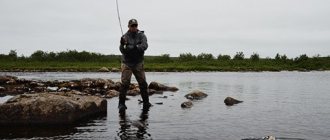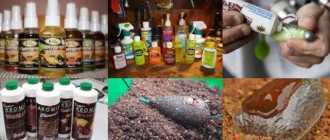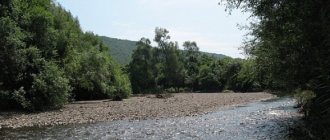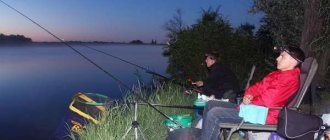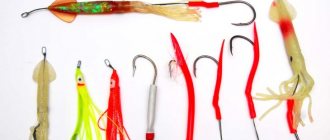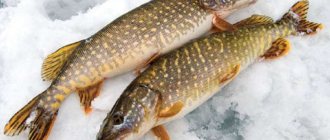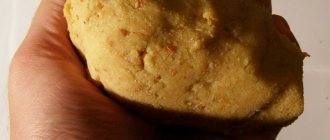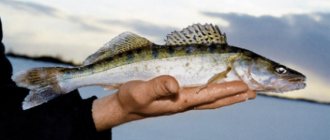Peninsula fish
The inland waters of the peninsula are home to 24 species of fish belonging to 12 different families. The most numerous of them are:
- Salmonids – whitefish, lake and brook trout (trout), grayling, vendace, char. Salmon and sea trout also enter the rivers to spawn.
- Cyprinidae - common roach, bleak, dace, minnow, ide;
- Cod - burbot;
- Perch - perch, ruff;
- Flounder – river flounder;
- Kerchak - sculpin goby.
The sea waters surrounding the peninsula are home to more than 100 species of fish, the most numerous of which are cod, sea flounder, pollock, haddock, Arctic char, catfish, and sea lamprey.
Salmon is the dream of any fisherman who comes to the peninsula.
Fishing places
On the Kola Peninsula there are a huge number of lakes, cold mountain and lowland tundra rivers and streams. In addition, in the region there are 2 large artificial reservoirs - the Verkhnetulomskoye and Kovdozerskoye reservoirs.
Lakes
The most visited lakes by fishermen on the Kola Peninsula are the following:
- Lovozero is the third largest lake in the region (water surface area is 208.5 km2) located in the central part of the peninsula. The average depth of the reservoir is 5.7 m, the maximum reaches 35 m. The lake is home to such species of fish as trout (trout), whitefish, grayling, and char. There are a lot of large pike and trophy perch in the reservoir.
- Seydozero is a picturesque reservoir located in the Lovoozersk tundra. Having a length of 8 km and a width of -2-2.5 km, it is filled with cold and clean water due to the flowing mountain river Elmorajok. Due to the average depth of 6 m, the environmental status of the lake itself and the adjacent lands that are part of the Seydyavvr reserve, a huge number of fish live in the reservoir. The most numerous species are whitefish, lake trout, grayling, pike, perch, and char.
- Umbozero is the deepest lake in the region: with an average depth of 15 m, the maximum reaches 115 m. Located in the central part of the Kola Peninsula between the Khibiny and Lovozero tundras, it has a water surface area of 422 km2. The waters of the lake are home to such species of fish as trout, salmon, arctic char, vendace, palia, burbot, and whitefish.
- Imandra is the largest lake in the region located in its western part. It has a length of 120 km, a width of 13-14 km and a water surface area of 876 km2. Despite the fact that with the wastewater from metallurgical and mining enterprises located on the rivers that feed the reservoir, a fairly large amount of substances harmful to the ecosystem enters it, the lake is very rich in fish. The waters of Imandra are home to species such as whitefish, grayling, lake char, vendace, pike, ide, burbot, perch, and lake trout.
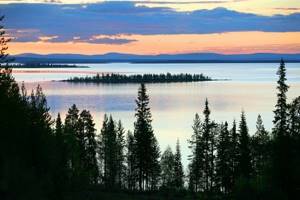
After the construction of a cascade of three hydroelectric power stations on the Niva River flowing from the reservoir, Lake Imandra found itself in a backwater zone and practically turned into a reservoir.
Climatic and natural features
The climate of the Kola region is not similar to the climate of other regions at the same latitudes. The Gulf Stream brings warmth. Therefore, on the northern coast of the peninsula in winter it is not as frosty as in central Russia. The Barents Sea does not freeze throughout the year. And Beloye has been under the ice for quite a long time.
The climate of the northern coast is influenced by the Barents Sea. In these parts, in the coldest month - February - the average temperature is about -10 degrees. In July, the average temperature here is 13 degrees Celsius. The further from the coast, the lower the average annual temperatures. In mountainous areas, summer is cooler - on average +10 in July. Winters are quite mild - an average of 13 degrees below zero in January with plenty of precipitation.
The weather on the peninsula changes frequently. In winter there are thaws, and in summer there are frosts - this is facilitated by high humidity. The least precipitation occurs in the northern regions, the most in the mountainous regions. The main natural feature of these places is the polar night and day. In winter, the sun does not appear for a month and a half, and in summer, for the same amount of time, the daylight does not set beyond the horizon.
There is snow here until the end of May. The lakes become free of ice in early June. At the end of this month there is rapid flowering and is already without night frosts. In mountainous areas, the change of seasons is slightly delayed. Autumn comes here at the beginning of September. And there are already frosts at night. Snow begins to fall in the mountains in mid-September, and begins to fall in other areas at the end of the month. The end of the summer fishing season on the Kola Peninsula is at the beginning of October. During this period, weather conditions for fishermen are no longer comfortable. But stable snow cover should not be expected before November. At the same time, small lakes become covered with ice. The thickness of the ice on the Kola reservoirs ranges from 70 to 110 centimeters.
In December and early January the sun does not come out. The days become longer and the weather becomes more stable only in March-April. However, even during these months, cold temperatures down to -30 degrees occur at night.
Tackle
A wide variety of fish species, as well as fishing conditions, requires a careful approach to the selection and configuration of gear:
- For river fishing for trout, whitefish, and salmon, special slow-action spinning rods and fly fishing are used.
- For fishing on lakes and reservoirs, in river bays, a spinning rod, float tackle, donka, and feeder are used. Pike and perch are caught using girders and mugs.
- For active tundra fishing, medium-length spinning rods and fly fishing are used.
- sea tackle - for catching pollock, haddock, flounder, and large halibut they use a sea tyrant and a durable spinning rod;
- For ice fishing - in winter, on the freezing reservoirs of the peninsula, they fish with jigs, balance beams, and vertical spoons. Pike and perch are caught using winter baits.
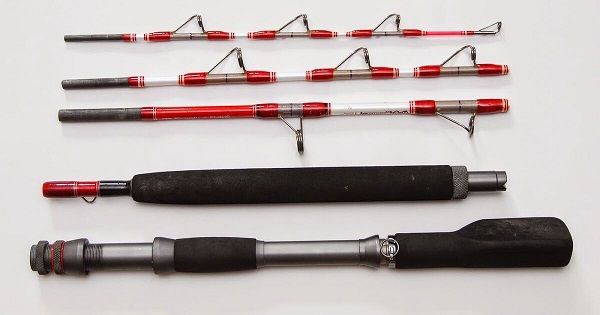
Spinning rod for sea fishing - a strong and short collapsible rod with a test weight from 400 to 1500-2000 g
Free fishing in the Murmansk region
The Kola Peninsula is a favorite vacation spot for many Russian and foreign fishermen. Fishing in Murmansk and its surroundings is very diverse, since you can fish not only in fresh water bodies, but also in the sea.
The Murmansk region has more than 1000 reservoirs, lakes and rivers, which are rich in fish such as: char, burbot, roach, salmon, whitefish, trout, pike, brown trout, perch, and palia. The most popular fish among fishermen are salmon, trout, salmon and brown trout. Fishing on the lakes and rivers of this region is open to visitors all year round.
Here are the TOP 5 best places where you can fish for free in the Murmansk region:
Lake Imandra
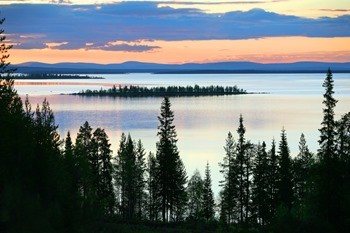
Description, what kind of fish is found, how to get there:
Located in the southwest of the Kola Peninsula. Total area – 876 sq. km - the largest lake in the European Subarctic. The greatest depth is 67 m, the average is 16 m. More than 140 islands. The largest island is Erm, area - 26 square meters. km. The lake is divided into three parts by channels. About 20 rivers flow in, and one flows out - the Niva. In some places the bottom of the lake is sloping. There is practically no aquatic vegetation.
On the shores of the lake there are large settlements - the city of Monchegorsk, the villages of Imandra, Tik-Guba, Zasheek, Khibiny, Afrikanda.
In the western part of the lake is the Lapland Nature Reserve.
Found: lake char; lake trout; brook trout; grayling; lake smelt; perch; ruff; minnow; burbot; ide; roach; vendace; salmon; whitefish; pike; nine-spined stickleback.
They fish from the shore or boat using a float rod, spinning rod, bottom and winter gear.
GPS coordinates:
Lake Kovdozero

Description, what kind of fish is found, how to get there:
South of the Kola Peninsula. 82 kilometers from Kandalaksha. It is connected to the White Sea by the Kovda River. The total area including the islands is 608 square meters. km. The greatest depth is 62 m, the average is 14 m. More than 580 islands. More than 30 rivers flow in, the largest being Iova. The lake is used for shipping.
Found: verkhovka; dace; bream; brown trout; tench; perch; peled; pit, ludny palya; loach; ide; roach; ripus; zander; vendace; grayling; whitefish; burbot; pike.
You can fish from the shore or boat using a float rod, spinning rod, or bottom tackle. Ice cover on the lake lasts from November to May. There are few mosquitoes and midges on the lake, and practically no ticks.
GPS coordinates:
Lake Semenovskoye
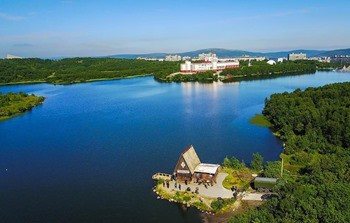
Description, what kind of fish is found, how to get there:
Located in the north of Murmansk in a recreation area. It is connected to the White Sea through the Kola Bay by the Semenovsky stream. Total area – 64.5 sq. km. The greatest depth is 17 m, the average is 4 m. The lake is available for fishing all year round.
Found: perch, trout, whitefish, pike.
They fish from the shore or boat using a float rod, spinning rod, bottom and winter gear.
GPS coordinates:
Lake Enozero

Description, what kind of fish is found, how to get there:
It is located in the northeast of the Kola Peninsula in the tundra zone. The Varzina River is connected to the Barents Sea. enoozeroThe Babya River flows into the lake. It consists of two parts connected by a wide (350 m) channel. There are no forests on the banks. Tectonic origin of the basin. The flat bottom is composed of boulders.
There are sandy beaches. 117 islands. Aquatic vegetation is practically absent. The coast is rocky. Total area – 64.5 sq. km. The greatest depth is 35.9 m, the average is 7.3 m. From time to time, industrial fishing is carried out on the lake.
Found: perch, brown trout, whitefish, pike.
You can fish from the shore or boat using a float rod, spinning rod, fly fishing, or bottom tackle.
Fishing in the Murmansk region is very multifaceted. This is a true fisherman's paradise. Here everyone will find a place and a way to go fishing successfully. You just need to take into account that catching salmon species requires a license and keep in mind that in some reservoirs there are restrictions and prohibitions on fishing.
GPS coordinates:
Verkhnetulomskoe reservoir
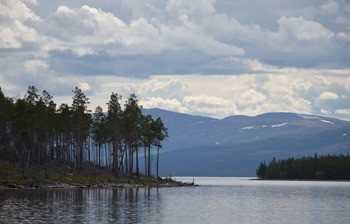
Description, what kind of fish is found, how to get there:
The Verkhnetulomskoye reservoir is located on the Kola Peninsula of the Murmansk region. Formed on the Tuloma River and Lake Notozero. The mirror area is 745 sq km. For those who like fishing in comfort, there are several camp sites, for example in the village of Verkhnetulomskoye. In addition to Tuloma, the reservoir is fed by the rivers Vuva, Myala, Sedm, Gireas, etc. There are many lakes in the vicinity of the reservoir.
Here you can catch the following fish: chub, coho salmon, brown trout, burbot, perch, whitefish, pike perch, grayling, pike.
GPS coordinates:
SEA FISHING IN MURMANSK
Most Murmansk fishermen prefer fishing in the Kola Bay of the Barents Sea, located within the city. On the most favorable days, the weight of the catch can be more than 30 kg. Fishing in the bay does not require the purchase of a paid license, which makes fishing accessible to all segments of the population.
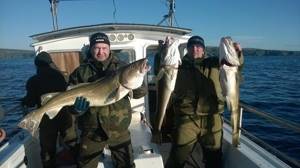
A fisherman who comes here for the first time should know that there are certain size restrictions for each type of fish. For example, the length of the caught pollock must be at least 40 cm. Otherwise, the trophy will have to be released.
Fishing on the bay is possible both from the shore and from a boat. When fishing on shore, fishermen's trophies often include:
- herring;
- capelin;
- haddock;
- flounder.
Herring and capelin show increased activity in August. They can be caught with light spinning tackle. Small oscillating jig-type spinners and silicone vibrating tails about 4 cm long are used as bait. Wiring should be carried out in the upper and middle layers of the water.
Haddock and flounder are caught from the shore using bottom tackle, which should include a fairly powerful rod with a test weight of up to 120 g and a 4000 series spinning reel. A monofilament or fluorocarbon line with a diameter of 0.35 mm is wound onto the spinning spool.
Many fishermen come to the Kola Peninsula to catch large cod in the Barents Sea. Sea bottom rigging consists of a heavy sinker, above which several leashes with hooks are tied. The diameter of the driving monofilament is usually about 0.25 mm. The size of the hook can range from 10 to 4 numbers (according to the international classification) and largely depends on the type of bait used. The bait is:
- sea worm;
- fresh shrimp;
- small vibrating tails made of “edible” rubber.
Sea worms can be found in the bottom soil during low tide. It is easier to purchase fresh shrimp at local fish stores. Excellent places for fishing with bottom gear are located near the village of Lavna. This area is characterized by numerous piers, fishing from which can be more effective than from the shore.
On a note! Sea bass, cod and pollock are biting well in the early autumn months. These types of fish stay at a considerable distance from the shore, so to catch them the fisherman will have to use a watercraft.
Local residents fish from both small rubber boats and large boats. There is constant movement of large sea vessels on the Kola Bay, so it is not recommended to move more than 200 m from the shore.
The largest representatives of the cod species are found in the open sea, however, in the bay there is a chance of catching a specimen weighing more than 8 kg. For such fishing, a powerful spinning rod equipped with a multiplier reel is used. A braided cord with a breaking load of at least 20 kg is wound onto the “multa” spool. A shock leader made of fluorocarbon fishing line with a diameter of 0.45 mm is attached to the “braided line”, to the end of which a heavy jig class spinner weighing 100–200 g is attached. Above the main bait, hooks with silicone baits attached to them are attached on short leashes. Fishing is carried out exclusively in the bottom layers of water.
The fisherman should remember that contact with salty sea water negatively affects all elements of the gear. After fishing, the rod, reel and monofilament should be thoroughly rinsed under fresh running water.
Do you know any other good places for fishing in the Murmansk region - write in the comments
